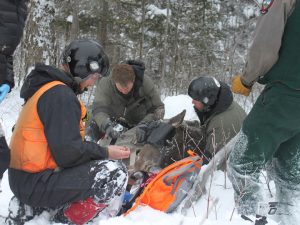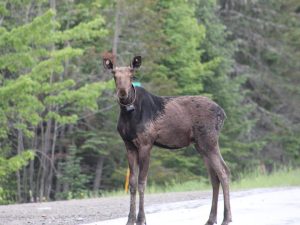The juvenile moose of Maine face two challenges in the dawn of their lives: harsh, frigid winters and thousands of parasitic ticks slowly draining their life source. The combination of the two establishes a low survival rate for these vulnerable moose calves, a phenomenon that may be aggravated by our warming climate.
Dr. Pauline Kamath from the University of Maine is currently working to estimate winter tick population abundance and how it might be affected by environmental change. Through her research she has observed these winter tick infestations wreak havoc on moose calves and cause a decline in moose populations across Maine. When infested with up to 70,000 – 95,000 ticks during the winter season, moose calves can experience hair loss and anemia, and many ultimately die. In 2022 and 2023, Dr. Kamath reported that greater than eighty-five percent of the collared moose calves did not survive their first winters.
As climate change makes winters warmer, these formidable winter tick populations are able to flourish. More favorable weather conditions allow for larval tick survival in the fall, along with high moose host densities, establishing a large tick population for the winter season. In collaboration with Maine Department of Inland Fisheries and Wildlife and Penobscot Nation Department of Natural Resources, Dr. Kamath’s valuable research aims to inform the management and longevity of this iconic Maine species.
According to Dr. Kamath, the North Atlantic Coast CESU has “allowed [her] to expand upon some of [her] lab’s ongoing research questions to more comprehensively examine winter tick infections in moose.” Our partnership with Dr. Kamath’s lab and the University of Maine has supported research on the various pathogens these winter ticks carry. Future research will include examining the effects of microclimate on tick populations and their survival, giving important insight into how changes in the environment will affect their abundance and distribution and the exposure risks to moose.




